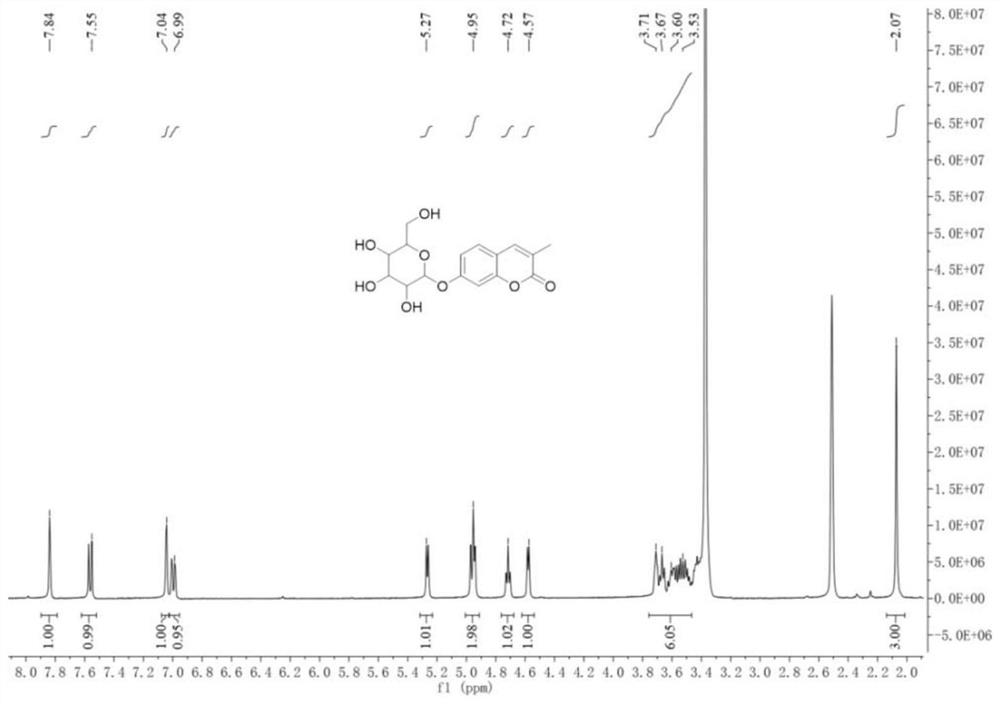Fluorescent probe for detecting beta-galactosidase as well as preparation method and application of fluorescent probe
A galactosidase and fluorescent probe technology, applied in the preparation of sugar derivatives, biochemical equipment and methods, fluorescence/phosphorescence, etc., can solve the problems of high cost, complex probe synthesis, etc. Good performance and high sensitivity
- Summary
- Abstract
- Description
- Claims
- Application Information
AI Technical Summary
Problems solved by technology
Method used
Image
Examples
Embodiment 1
[0042] A fluorescent probe for detecting β-galactosidase, the preparation method of which comprises the following steps:
[0043] 1) Synthesis of compound a: Weigh 1g of 2,4-dihydroxybenzaldehyde (7.2mmol), place 1.57g of sodium propionate (16.3mmol) in a 25mL round-bottomed flask, measure 3.16mL of propionic anhydride ( 24.5mmol), 1.15mL of dry triethylamine (8.3mmol) were added to the above system, heated to 170°C and refluxed for 2h, the reaction was complete as monitored by TLC, after the reaction was completed, cooled to room temperature, stirred with water, at this time there were a large amount of white solid separated out, then extracted with ethyl acetate, washed the organic phase three times with water, anhydrous MgSO 4Drying, spin-drying, and then by column chromatography (ethyl acrylate:petroleum ether=1:6, v / v) to obtain a light yellow solid, then recrystallized with ethyl acrylate, after vacuum drying to obtain 1.1g of product a, the yield About 65%. product a ...
Embodiment 2
[0055] Measure the effect of the fluorescent probe obtained in Example 1 and β-galactosidase reaction:
[0056] Add 3mL of fluorescent probe molecules prepared in Example 1 (10 μM, dissolved in PBS buffer solution with a pH value of 7.4 at 37°C) to the cuvette as a control group, test its ultraviolet absorption spectrum and fluorescence spectrum, and then In another cuvette, add 3 mL of fluorescent probe molecules prepared in Example 1 (10 μM, dissolved in PBS buffer solution with a pH value of 7.4) and a mixture of β-galactosidase (0.10 U / mL) as The experimental group tested its ultraviolet absorption spectrum and fluorescence emission spectrum. Such as Figure 7 Shown is the high performance liquid chromatography and mass spectrometry of the fluorescent probe detecting β-galactosidase. It can be seen from the figure that β-galactosidase breaks the D-galactosidic bond and releases the fluorescent group, which illustrates the reaction mechanism of the probe Consistent with a...
Embodiment 3
[0058] Measure the change of the concentration of the fluorescent probe obtained in Example 1 and the β-galactosidase reaction intensity of different concentrations:
[0059] Add 3 mL of fluorescent probe molecules (10 μM, dissolved in PBS buffer solution with a pH value of 7.4 at 37° C.) and different concentrations of β-galactosidase (0 , 0.01, 0.03, 0.05, 0.07, 0.1, 0.15U / mL) mixed solution, after reacting for 15 minutes, test the fluorescence spectrum of each mixed solution. As the concentration of β-galactosidase increases (0-0.10U / mL), the fluorescence intensity increases gradually, and a red shift occurs at the same time. However, when a larger amount of β-galactosidase (0.15U / mL) was added, the fluorescence intensity no longer increased, which indicated that 0.10U / mL β-galactosidase could catalyze the hydrolysis of 10 μM fluorescent probe, different The titration test chart of the concentration of β-galactosidase to the fluorescent probe is as follows Figure 11 show...
PUM
 Login to View More
Login to View More Abstract
Description
Claims
Application Information
 Login to View More
Login to View More - R&D
- Intellectual Property
- Life Sciences
- Materials
- Tech Scout
- Unparalleled Data Quality
- Higher Quality Content
- 60% Fewer Hallucinations
Browse by: Latest US Patents, China's latest patents, Technical Efficacy Thesaurus, Application Domain, Technology Topic, Popular Technical Reports.
© 2025 PatSnap. All rights reserved.Legal|Privacy policy|Modern Slavery Act Transparency Statement|Sitemap|About US| Contact US: help@patsnap.com



